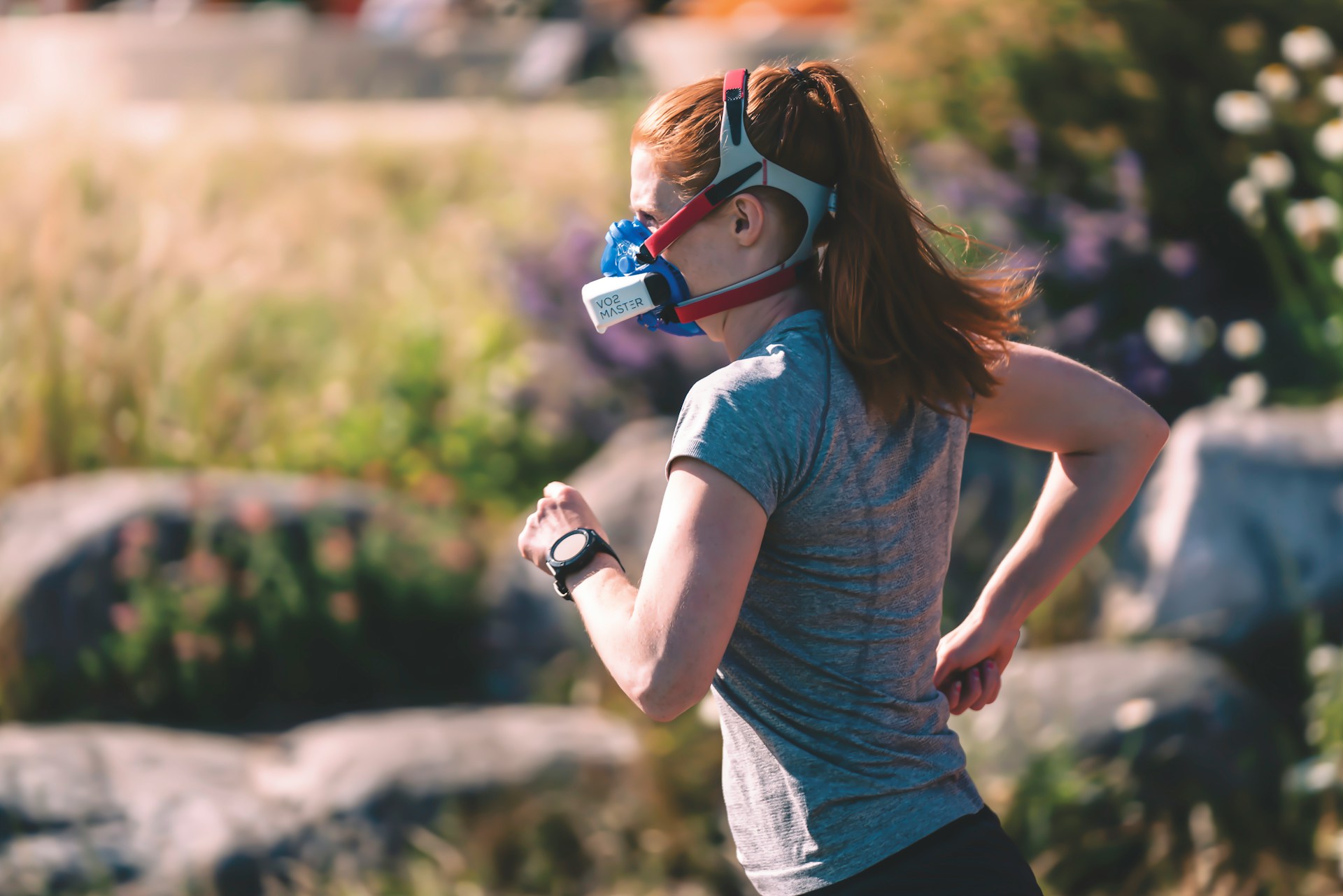Science
Feb 2, 2024
Improving VO2max: How to increase your maximum oxygen uptake
VO2max – the maximum oxygen uptake – is a key measure of aerobic endurance performance. It indicates how much oxygen can be processed in the body per minute. A high VO₂max means that the body can transport more oxygen to the muscles and thus provide more energy. For many athletes and fitness enthusiasts, it is therefore an important goal to improve their VO2max in order to increase their performance and reach their full potential.
In this blog post, you'll learn what VO₂max is, which physiological factors influence it, and how you can specifically design your training to effectively improve your VO2max.
What does VO₂max mean?
VO₂max describes the maximum amount of oxygen (O₂) your body can take in during maximum exertion. It is measured in liters per minute (l/min) or as a relative number per kilogram of body weight (ml/min/kg) and is an indicator of cardiovascular fitness and aerobic capacity. The measurement is usually done through a respiratory gas analysis during sport-specific tests on a bicycle ergometer or treadmill [8].
How is VO₂max measured?
VO₂max is typically determined through respiratory gas analysis. During exertion, the amount of oxygen taken in and the amount of carbon dioxide expelled is analysed. This measurement is particularly helpful in optimising training to improve VO2max [6].
Physiological factors influencing VO₂max
VO₂max depends on several physiological factors. Two essential components are cardiac output and arteriovenous oxygen difference [1].
1. Cardiac output (CO): Cardiac output describes the amount of blood the heart pumps per minute and is composed of heart rate and stroke volume. With regular endurance exercise, stroke volume increases as the heart pumps more blood per beat. A trained "athlete's heart" can thus transport more oxygen to the muscles and sustainably improve VO2max [1][7].
2. Arteriovenous oxygen difference: This describes the difference in oxygen content between the arteries and veins. A larger difference indicates that more oxygen is available – ideal for those who want to improve their VO2max [7].
Standard values of VO2max
For non-endurance athletes, the average VO₂max is about 3 - 3.5 l/min. Endurance athletes reach values of 5 - 6 l/min. In relative terms, VO₂max in untrained individuals is between 35 - 50 ml/min/kg, while well-trained endurance athletes often achieve values of 80 - 90 ml/min/kg [6][7]. To achieve such values, regular training to improve VO2max is required.
How can I improve my VO2max?
To improve your VO2max, training with an effective ratio of intensive and regenerative units is important. Studies show that a bipolar training model with about 80% regenerative and 20% intensive units is particularly effective [2].
Intensive training for higher VO2max
Training sessions in high-intensity ranges such as HIT (High Intensity Training) are particularly effective. At more than 88% of VO₂max, the cardiovascular system works at its limit and transports a lot of oxygen to the muscles. This challenges the maximum oxygen uptake capacity and is a targeted approach to effectively improve VO2max [4][5].
Examples of training sessions to increase VO₂max:
Interval training: Short, intense intervals (e.g., 4 x 4 minutes at high intensity with 3 minutes rest) effectively stimulate the cardiovascular system [11].
Longer HIT sessions: Longer intensive phases (e.g., 30 minutes at 85-90% of maximum heart rate) also improve oxygen uptake capacity and contribute to improving VO2max [9][12].
Regenerative training sessions for recovery
To avoid overload, these intensive sessions should be combined with regenerative sessions. Through a low training volume (e.g., easy cycling or running), the body can recover from the intensive phases. This balance is crucial for anyone looking to improve their VO2max [2].
Importance of body composition and body weight
To optimally utilise VO2max in sports, it should be considered in relative terms (ml/min/kg), as higher body weight affects oxygen consumption. A lighter athlete can use more energy per kilogram of body weight with the same absolute VO₂max and has an advantage when the goal is to improve VO2max [10].
Conclusion: Achieving higher VO2max through targeted training
Improving VO2max is an attractive goal for endurance athletes and fitness enthusiasts as it is a measure of cardiovascular fitness and aerobic potential. Through a structured training program with intensive units and regenerative phases, VO₂max can be sustainably increased. The bipolar training model with a ratio of 80% to 20% ensures that your body optimally adapts to the stress while avoiding overtraining [3][11].
With the right training strategy and regular exercise, you can improve your VO2max and continuously enhance your athletic performance.
Tessa Menges
Author
Sources
[1] Basset, D.R. & Howley, E. T. (2000). Limiting factors for maximum oxygen uptake and determinants of endurance performance. Med Sci Sports Exerc 32: 70-84.
[2] Faude, O., Meyer, T., Scharhag et al. (2008). Volume vs. intensity in the training of competitive swimmers. International Journal of Sports Medicine. 29(11): 906-912.
[3] Fiskerstrand A, Seiler KS. Training and performance characteristics among Norwegian international rowers 1970-2001. Scand J Med Sci Sports. 2004;14:303-310.
[4] Gormley, S., Swain, D., High, R., et al. (2008). Effect of intensity of aerobic training on V̇O2max. Medicine and Science in Sports and Exercise, 40(7): 1336-1343.
[5] Gutin, B., Barbeau, P., Owens, S., Lemmon, C. R., Bauman, M., Allison, J., ... & Litaker, M. S. (2002). Effects of exercise intensity on cardiovascular fitness, total body composition, and visceral adiposity of obese adolescents. The American journal of clinical nutrition, 75(5): 818-826.
[6] Kramme, R (2016). Organ profiles and standard values BT - medical technology: procedures - systems - information processing. 1-28.
[7] Meyer, T. & Kindermann, W. (1999). The maximal oxygen uptake (VO2max).German Journal of Sports Medicine, 50(9): 285-286.
[8] Meyer, F., Borst M., Buschmann, H. et al, (2018). Exercise testing in pneumology - Recommendations of the German Society for Pneumology and Respiratory Medicine e. V.. Journal of Pneumology. 687-731.
[9] O'Donovan, G., Owen, A., Bird, S. R., Kearney, E. M., Nevill, A. M., Jones, D. W., & Woolf-May, K. (2005). Changes in cardiorespiratory fitness and coronary heart disease risk factors following 24 wk of moderate-or high-intensity exercise of equal energy cost. Journal of applied physiology, 98(5): 1619-1625.
[10] Péronnet, F. & Thibault, G. (1987). Physiological analysis of running performance. Revision of the hyperbolic model. Journal of Physiology, 82(1): 52-60.
[11] Seiler, S. (2010). What is best practice for training intensity and duration distribution in endurance athletes? International Journal of Sports Physiology and Performance. 5(3): 276-291
[12] Swain, D. P. & Franklin, B. A. (2006). Comparison of cardioprotective benefits of vigorous versus moderate intensity aerobic exercise. Am J Car- diol. 2006; 97:141-7.








